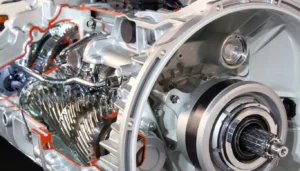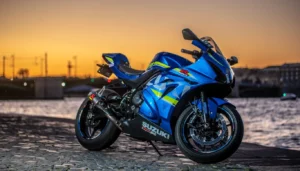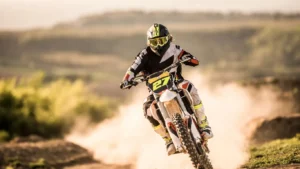Both beginners and experienced riders like riding dirt bikes. The ideal approach is to adopt a spirit of curiosity and appreciation for life. Start with this advice for new riders if you want to learn how to ride a dirt bike like a pro. However, you must prioritize safety above all else.
To ride a dirt bike like a pro, you must first understand the fundamentals, such as how to shift it correctly, use the clutch, and learn how to handle the bike. If you adhere to these guidelines while riding, you will improve as a rider very quickly.
The right techniques and strategies can put you in a positive spirits. If you do it with the right skills and information, it may be a thrilling pastime for your life.
You’ll become a master in this world of adventure as you get more experience. The majority of us lead full lives without being able to pinpoint a profession that entices our interests and makes us content.
Knowing how to ride a dirt bike with or without a clutch is an advanced skill that might satisfy a desire for the activity.
I advise you to follow each step exactly, put it to memory like concrete, and read it over until you can correctly recall each step.
Step by step method to learn dirt bike riding
Developing improper riding habits on a dirt bike might seriously hurt you. It can be challenging to find the perfect items to get back to the proper practice after you are aware of your poor habits.
Good riding methods might help you have the most pleasure when riding a dirt bike because fundamentals are important in every field.
Suitable body Positioning, control skills, not getting into bad habits, and choosing the right bike size are the most important parts of riding a dirt bike.
You get comfortable riding a dirt bike after four or five rides. You will learn the fundamentals and be able to ride on any track if you persevere.
The following are the steps that a beginner should take in order to ride a dirt bike:
| Step 1. | Learn the Controls |
| Step 2. | Use of Clutch |
| Step 3. | Shifting & Braking |
Step 1. Learn the Controls
You came to this page because you want to learn how to ride a dirt bike, but before you do so, you need to be familiar with all of the controls on the bike and how to operate them.
You can’t go ride your bike, can you?
You should be familiar with the bike’s braking system before attempting to ride it. How to utilize the clutch and shift gears on a manual transmission dirt bike.
Imagine you are in the middle of the field when you start the bike; now tell me how you plan to bring it to a stop. if you are a novice and don’t know because you are just starting out. It may cause you serious harm.
Now that we’ve got that out of the way, let’s go through each of the controls one at a time, paying close attention to what we’re doing because these are the most crucial aspects of learning how to ride it.
The Clutch Lever on Left Side:
Have you ever heard about how a clutch works and what exactly that mechanism is called? The clutch is located in the dirt bike between the gearbox and the engine. The intention is to break the connection that sends power from the engine to the transmission.
The power necessary to propel a dirt bike is produced by the engine, and then transmitted via the gearbox to the rear wheel via sprockets or chains. The rear wheel is responsible for both propelling and being propelled by the bike.
A clutch Lever is present on the Left-handle bar.
Tip: Use only two fingers to hold and control the clutch lever.
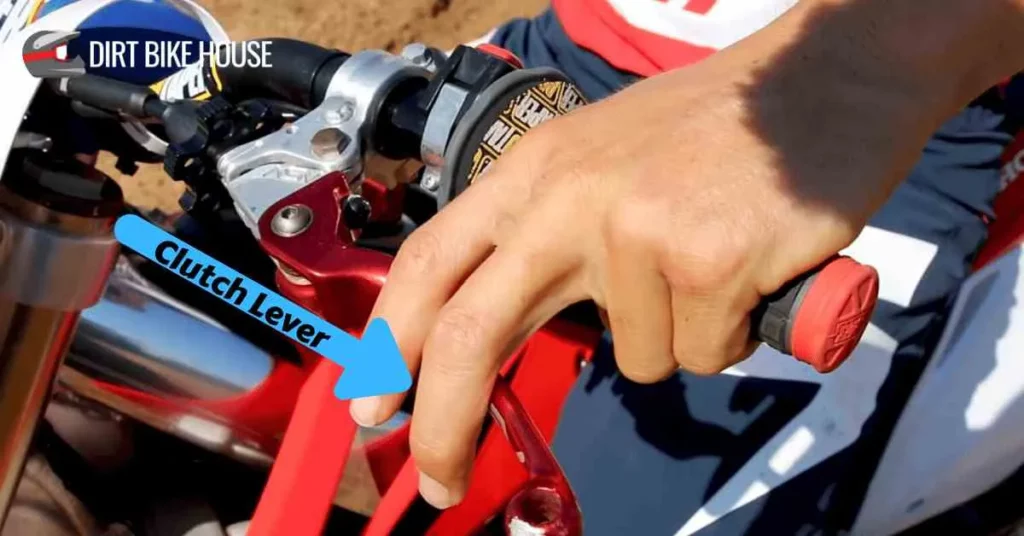
Tip: Use only two fingers to hold and control the clutch lever.
Front Brake on Left Side:
If we do decide to use the brakes, we should focus on applying three quarters of the required force to the front brake in particular. On the other hand, we frequently avoid doing this out of concern that the front wheel will lock up.
The moment immediately prior to when the wheel starts to skid is the optimal time to apply the brakes. The ideal situation is when you skid the front wheel while simultaneously applying the brakes on the dirt bike.
You have to have the awareness that this is just a fear, and you should face it without any trepidation.

Throttle on Right Handlebar:
When riding a dirt bike, having complete command of the throttle is essential to your performance, regardless of whether you’re competing on a track or in a trial.
Becoming a professional rider requires that you have a balanced command of the brakes, the clutch, and the throttle. You will find the controls for the throttle located on the right handlebar.
Learning how to control the throttle is the hardest part of learning to ride a dirt bike. When a rider has problems, like a broken or stuck throttle, the motorcycle may not work as well.
The term “accelerator” can also be used to refer to the “throttle.” When we use the clutch to turn on the engine through the gearbox, we can move the dirt bike.
A problem with the throttle can also be caused by bad maintenance or damage from any kind of collision.
Shifting on Your Left Foot:
Actively shifting the gears requires you to use the foot on your left side.
After you have started the engine, whether by kicking it or by pressing the button for the automatic self-start, you need to make sure that the gear is in the neutral position.
It is possible to start it while the gear is engaged, but you will need to pull the clutch in order to do so if the gear is not in neutral.
Pulling the clutch back makes changing into any gear, starting from neutral, a very simple and easy process.
Immediately following the activation of the engine, you will need to select “first” as the gear, followed by “second,” and then “third.” Depending on the specific model of the dirt bike, it may have as many as six different gears.
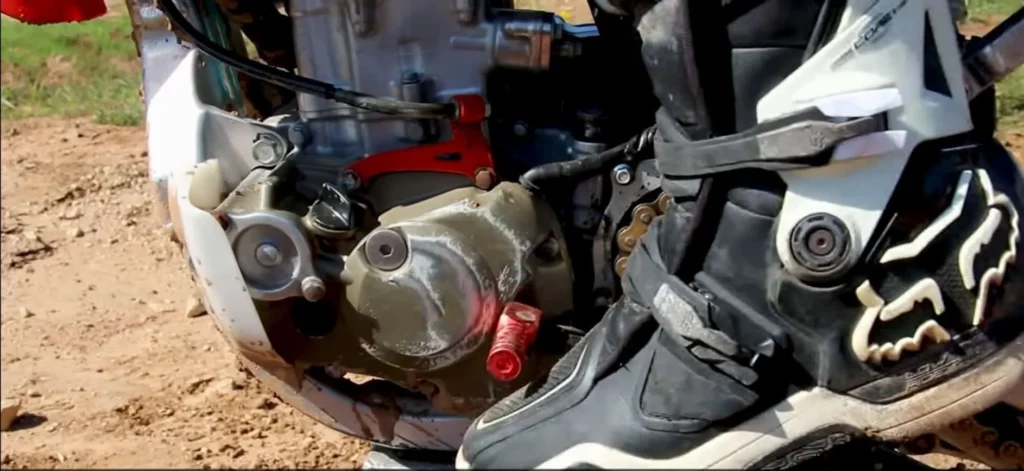
According to automation, there are reportedly many distinct types of dirt bikes. Here we are discussing manual bikes.
If you are interested in learning more about semi-automatic bikes, you can learn more by reading the in-depth post that explains what exactly a semi-automatic dirt bike is.
Rear Brake on Right Foot:
The vast majority of people enjoy going fast, but when it comes to stopping, you should move as quickly as possible. Seventy-five percent of all braking is done with the rider’s front brake. In addition, the front brake is an extremely important component when riding dirt bikes.
Your legs are resting on pegs, which not only provide you with the right balance but also keep you from bouncing off the pegs as you travel through difficult terrain.
You have to utilize the front brake in conjunction with the rear brake smoothly. In this situation, the front brake is absolutely necessary.
You should keep in mind one thing, and that is to avoid locking up the front wheels as much as possible. In the event that the front wheels become stuck, the vehicle will crash, and the mud will get all over your face.
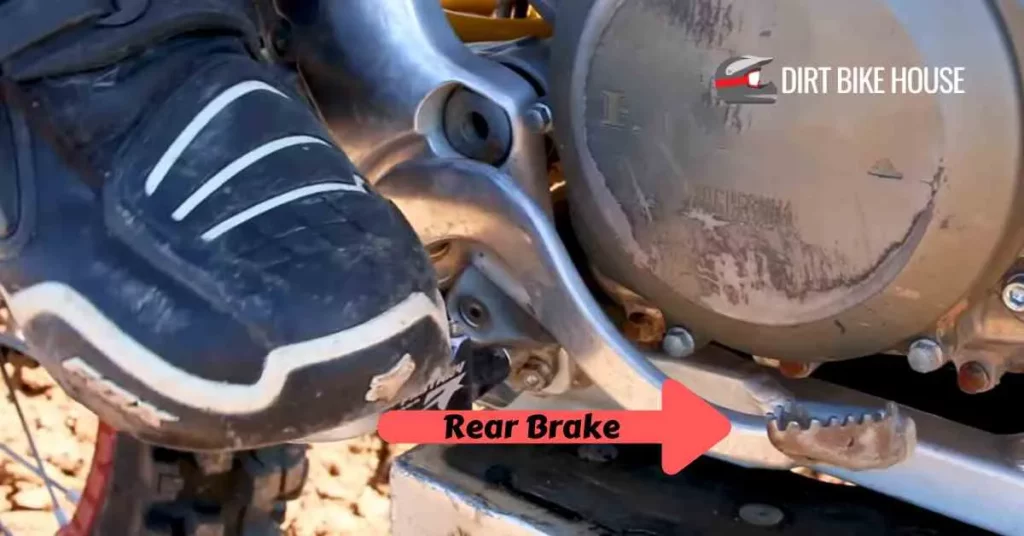
Kick Start on Right Foot Side:
You’ll find a Kick lever for starting the engine when you look at the right foot side of the vehicle. There is nothing comparable to that; the dirt bike can be started without the use of a key.
There are no keys for dirt bikes, regardless of whether they have a kick start or an electric start. If it has an electric start, you will have a button that you can push to start it, and if it does not, you will have to kick the lever or pedal to get it going.
A cold start occurs when the engine is cooled down to its normal operating temperature before the starting process begins. When beginning with a kick, you might have to give it several tries before you get it right.
If, on the other hand, you have been riding a bike since the morning and you turn off the engine after a few hours and then try to start it again, it will only require one kick to get going again.
Auto Start by Push Button on Left Handle-Bar:
Riders who are interested in switching from two- to four-stroke engines or who have already made the switch to four-stroke engines contribute to the growing demand for electric starters. Because of the high compression, four-stroke engines are notoriously difficult to start.
The majority of riders believe that when they kick two strokes, it is more pleasant; nevertheless, when it comes to four-strokes, it generally demands more work on the rider’s part.
In most cases, the auto-start push button is provided for four-stroke engines so that riders do not have to fight to start the engine by using the starter.
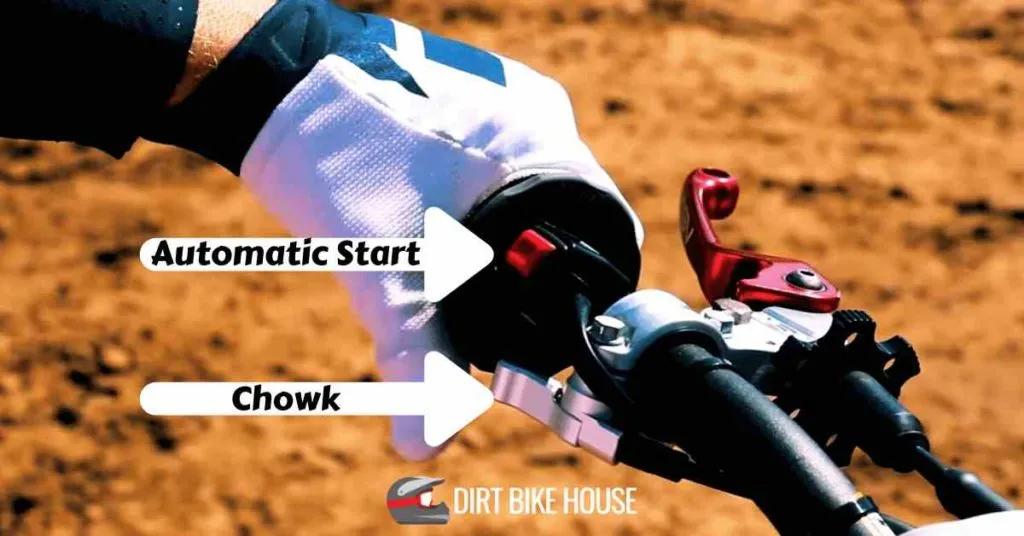
Step 2. Use of Clutch
When your clutch is completely under control, you can ride like a pro. It is a crucial control that helps you become the best rider possible. Do you, however, understand how a clutch operates and what it does for a dirt bike?
You’ll remain secure and at ease thanks to it. Please slow down; it is the most important. Spend some time learning it thoroughly.
If you’ve never been on a bike before and are brand new to this, the clutch must be in the disengaged position when the bike is in gear.
These must be present whenever the bike is in gear. No matter what gear the bike is in, it cannot move if the clutch is pulled in to disengage the transmission.
The most crucial thing is to pull it back as soon as you feel the bike start to move, which is the point of engagement. When you are ready to move, let it be up very slowly until you feel the bike move.
then perform several repetitions of feeling the point of engagement. Since few people are in their initial learning stages, you will feel at ease using the clutch and you won’t be surprised.
Note: Use one finger of the right hand to apply the front brake and the first two fingers to control the clutch lever.
Find the clutch’s engagement point when the bike begins to move, and then repeatedly practice letting the clutch in and out. Use very little to no throttle when exercising. The bike slowly extends the clutch past the point of engagement while adjusting the throttle by about 1/8 to 1/4 of a turn.
Always start in neutral if you are a beginner.
Right!
Of course, This article is for you, so you are reading it.
Your question will be, how can you find the neutral?
Very simple.
Just shift your gear to the first gear and then upshift halfway to the second gear. It is between the first and second gear.
Right!
Of course, This article is for you, so you are reading it.
Your question will be, how can you find the neutral?
Very simple.
Just shift your gear to the first gear and then upshift halfway to the second gear. It is between the first and second gear.
Step 3. Shifting & Braking
The final and most crucial step is to make your beast slower. While taking off is crucial, a safe landing is equally important.
The bike must be started and ridden, but it must also be slowed down and stopped safely in order to be in a good position.
Your braking system must be comfortable for you. Always practice in first gear when starting out.
Next, shift it into second gear. Additionally, you can decrease the gear by pushing with your toe on the opposite side. Be careful not to slam on the rear brakes. Apply a light downward pressure.
If any front brake is used at all, it should only be a small amount at first because you need to be familiar with your surface before using any front brake.
There is a lot of time when people give the front brake too hard and check the front end.
If you apply the front brake excessively, your front wheel will lock and the bike will leap. Additionally, failure to slightly apply the front or rear brakes can lead to an accident.
Most Important Tips for Beginners
Structure of Your Upper Body:
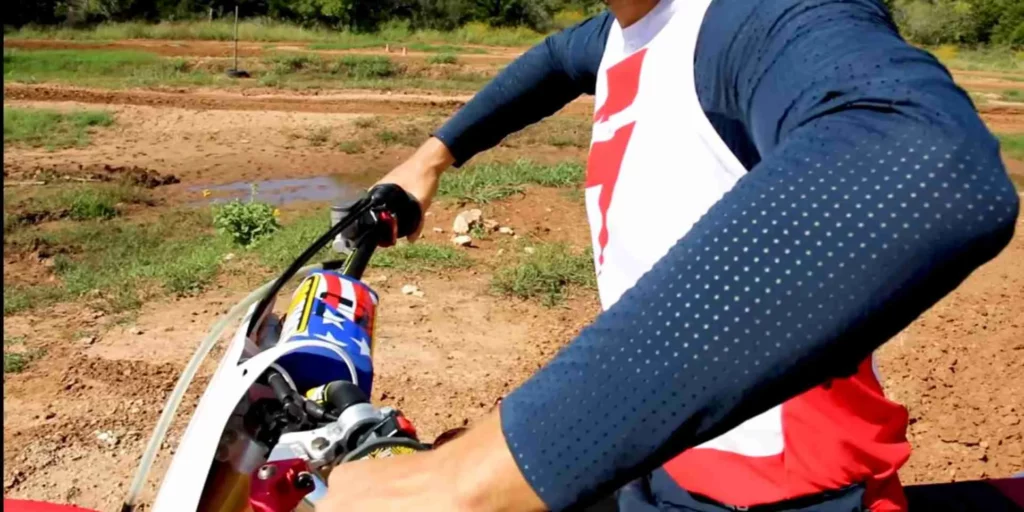
When you hold the handlebars, your chest, elbows, and handlebars should form a rectangle.
In order to encourage the elbows to close the ribcage, you should avoid gripping the handlebars with your hands straight in.
There should be a small v-shape here in your grip, and you should think about raising that elbow to keep it away from your ribcage.
Your arms should be held in a straight position from the knuckles to the elbow, with no slanting or bending at the top.
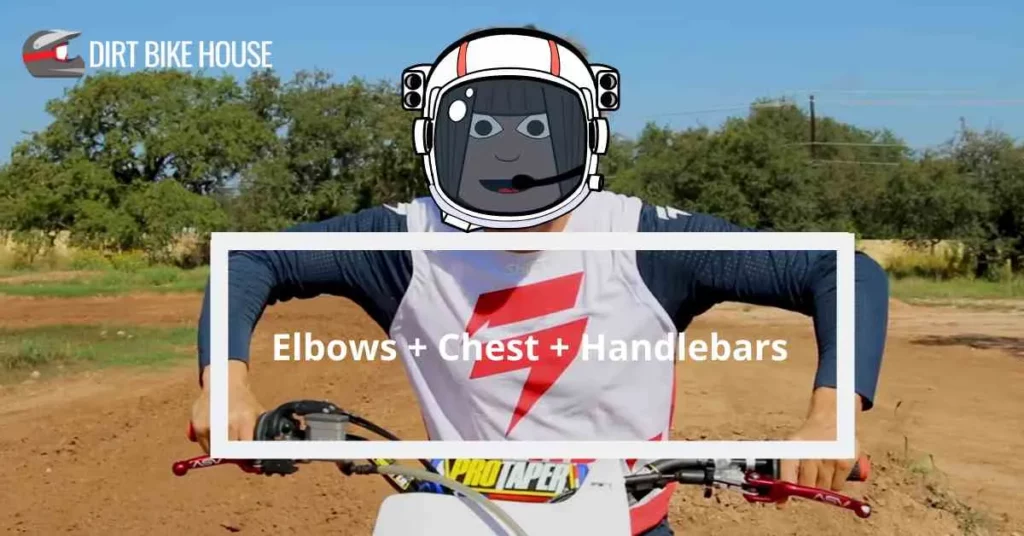
Attach Your Body to the Bike:
This one is crucial because you should consider attaching your body to the bike as you increase your speed and control. Just imagine that your bike is an extension of your body.
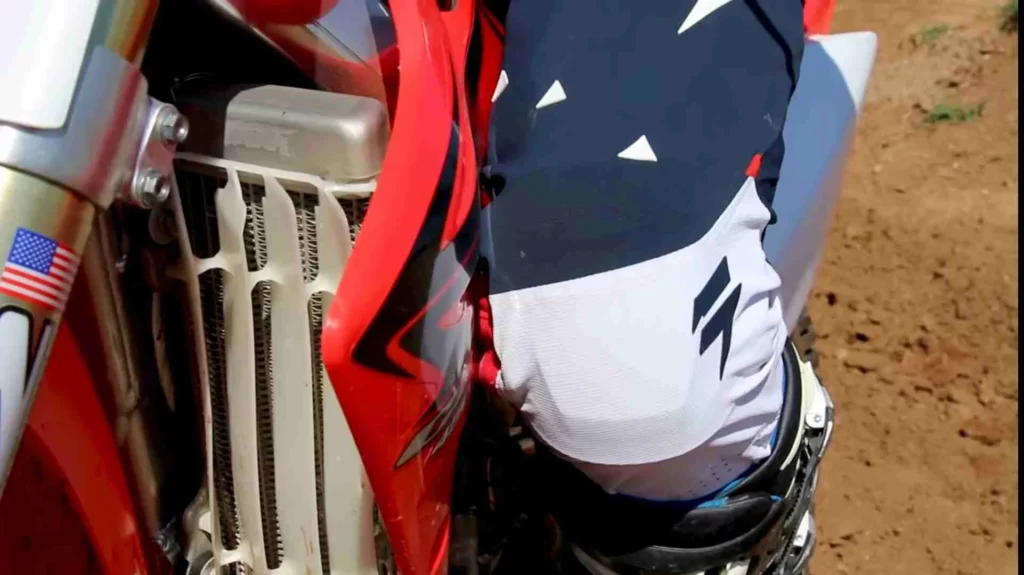
Every time you ride the bike, simply get on your knees and exert pressure on the entire machine. Building your muscles around exerting pressure requires some practice. For it, considerable training is needed. However, if you concentrate on this, your riding will be 100% safer and better.
Frequently Asked Questions [FAQ]
People mistakenly believe that riding a dirt bike is not difficult. Following all the regulations before you ride will make your life exciting, but ignoring the safety measures can be harmful to your health. Injury can result from using unsafe riding techniques and not wearing safety gear.
Here are the steps of riding a dirt bike.
Step 1. Learn the Controls Step 2. Use of Clutch Step 3. Shifting & Braking
Here are the bikes which are easy to ride.
Honda CRF250X, Yamaha YZ125, Kawasaki KLX110, & Honda CRF230F.
If you ask, I’d say there’s no particular time to learn to ride. It depends on how long he takes to learn to ride. Driving schools offer people a duration as long as they grasp and take each one as a regular learner. Few schools provide 3-6 months to become a good rider. Few riders master it quickly, and few take a long time.
If the bike fits your height and weight, riding can be comfortable. For a skilled rider, 6 feet above 450 can be a good height. If you’re under 6 feet tall, choose a 250 bike.
Downshifting is clutch-free. It can be pressed without pulling the clutch. Upshifting requires the grip.
A dirt bike Consisting of the actual automatic clutch is the real automatic dirt Bike. Only one KTM 50 SX is an automatic bike with a centrifugal multi-disc automatic clutch.
If you’re careless and lack mind control, a dirt bike is dangerous. Anyone who can regulate the throttle and sustain speed is safer. Trail riding injuries are common.
Used dirt bikes are best for beginners. Falling while studying helps you learn. After some riding expertise, buy a new one.
A rider’s feet, elbows, chest, and handlebars should form a rectangle. Most importantly, imagine your body as part of the bike.
Conclusion
If you go through the steps in the guide that we have provided for you above on how to ride a dirt bike for beginners step by step, I have no doubt that you will be able to ride the bike that you just purchased in the coming days.
It does not take a rocket scientist to figure out how to ride a dirt bike; in fact, anyone can teach you how to do it, even if you have never ridden a bike before.
You need to pay attention to all of the instructions that we offer you, and if you do so, you will become an expert on the dirt bike.

